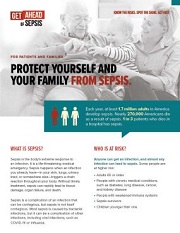Im Bringing Sepsy Back by Kern Medical Center. Patient education and patient engagement.
What Is Sepsis What The Public Needs To Know Lippincott Nursingcenter
Sepsis in its most severe form septic shock can carry mortality rates well above 50 even with optimal sepsis treatment.

Sepsis patient education. A Quality Improvement Project Kevin Mark Smith Jr Sepsis is a complication caused by the overwhelming and life-threatening response of the body to an infection. Sepsis is a common and potentially life-threatening condition triggered by an infection which causes the bodys immune system to go into overdrive and if it not treated quickly it can lead to multiple organ failure and death. Patient and caregiver education is also an important part of improving patient safety he continued.
Its possible for sepsis to begin with a small cut that gets infected or an infection that develops after surgery. In sepsis patients immune system goes into overdrive setting off a series of reactions including widespread inflammation. Sepsis is the bodys extreme response to an infection.
Hospitalizations for sepsis have more than doubled over the last 10 years and in many countries more people are hospitalized each year for sepsis than for heart attack. To ensure appropriate skills and knowledge for the recognition and management of the patient with sepsis. Patient Education Television Channles.
Evidence-based guidelines incorporate infection source control of sepsis with empiric antibiotics restoration of tissue perfusion intensive blood glucose control and use of glucocorticoids and activated drotrecogin alfa. Sepsis happens when an infection in skin lungs urinary tract blood or somewhere else triggers a massive physiologic response throughout the body. Promoting Sepsis Awareness and Education.
Best Practices for Sepsis Patients. Strictly speaking septicaemia is an infection of the blood whereas sepsis refers to the whole body. This response results in a cascade of changes that damage multiple.
Here are four learning objectives to use or modify for an EMS. UCLA Education Training Module - This training module takes approximately 20 minutes to complete and will guide the user through identification diagnosis and proper treatment of sepsis severe sepsis and septic shock. Showing records 1 - 5 of 5 Promoting a Better Understanding of Sepsis International Sepsis Forum.
Care Guides From Your Clinician - The Clearinghouse for Patients. When the Signs of Sepsis are Missed. Your bodys defense system normally releases chemicals to fight off infection at the infected area.
In the United States the incidence of post. Sepsis often results from infections to the lungs stomach kidneys or bladder. Watch video Physician Resources.
Simulation education can be useful in educating EMS providers both basic and advanced in both sepsis recognition and treatment. Sepsis is a life-threatening condition that arises when the bodys response to an infection causes it to attack its own tissues and organs. Stories from patients and families A Back to Basics Approach to Prevent Infection My Story.
Anyone can get sepsis. Sepsis happens when an infection spreads and causes your body to react strongly to germs. You may also hear severe infection being referred to as septicaemia.
The germs involved in sepsis can be bacteria viruses or fungi. JobAid - Learn how to Search the Clearinghouse. Despite such findings many hospitals and health systems underuse powerful resources for preventing readmission.
Sometimes sepsis can occur in people who didnt know that they had an infection. It claims more lives than lung cancer and is the second biggest killer after cardiovascular disease. CDC offers free educational resources to help prevent sepsis or spot it early when it happens.
Sepsis can lead to tissue damage organ failure and death Center for Disease Control and Prevention 2016. Worse the estimated average cost per readmission for sepsis is 10070a figure that also exceeds the costs of each of the four other conditions. When infection spreads chemicals are released throughout your body.
A survey released by The Sepsis Alliance ahead of Sepsis Awareness Month in September found that only 55 percent of Americans had even heard of sepsis and just 28 percent could correctly identify its symptoms. Page 1 of 1. Sepsis is a reaction by the body to severe infection.
International studies show that 20-40 of sepsis patients requiring intensive care treatment developed sepsis outside the hospital.

